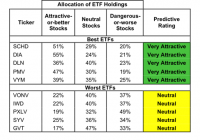5 Large-Cap Blend Funds For Growth And Value Investing
Blend funds are a type of equity mutual fund which holds in its portfolio a mix of value and growth stocks. Blend funds are also known as “hybrid funds”. Blend funds aim for value appreciation by capital gains. It owes its origin to a graphical representation of a fund’s equity style box. In addition to diversification, blend funds are great picks for investors looking for a mix of growth and value investment. Meanwhile, large-cap funds usually provide a safer option for risk-averse investors, when compared to small-cap and mid-cap funds. These funds have exposure to large-cap stocks, providing long-term performance history and assuring more stability than what mid-cap or small-caps offer. Below we will share with you 5 buy-ranked large-cap blend mutual funds. Each has earned a Zacks Mutual Fund Rank #2 (Buy) as we expect these mutual funds to outperform their peers in the future. Deutsche Core Equity S (MUTF: SCDGX ) seeks capital appreciation along with current income and income growth. A lion’s share of its assets is invested in equities or mostly in common stocks. SCDGX invests mostly in large US firms, but is not restricted by market capitalization limitations. The Deutsche Core Equity S fund has returned 13.6% over the past one year. SCDGX has an expense ratio of 0.59% as compared to category average of 1.04%. PNC Large Cap Core C (MUTF: PLECX ) invests in broad range of US equities of large-cap firms, including American Depositary Receipts, preferred stocks, warrants and rights. A lion’s share of PLECX’s assets is invested in firms with at least $3 billion worth of market cap. The PNC Large Cap Core C fund has returned 12.5% over the past one year. Douglas J. Roman is the fund manager and has managed PLECX since 2009. Northern Large Cap Equity (MUTF: NOGEX ) seeks to provide long-term capital appreciation. NOGEX invests a majority of its assets in large-cap firms. These companies will have a market capital, at the time of purchase, within the range of those listed in the S&P 500 Index. Northern Large Cap Equity fund has returned 10.3% over the past one year. As of June 2015, NOGEX held 57 issues, with 5.21% of its total assets invested in Apple Inc (NASDAQ: AAPL ). JPMorgan US Equity R5 (MUTF: JUSRX ) aims to provide high total return. JUSRX invests a lion’s share of its assets in domestic companies. JUSRX mostly invests in common stocks of mid-to-large-cap domestic firms. It may also invest a maximum of 20% of its assets in foreign companies. JPMorgan US Equity R5 fund has returned 10.2% over the past one year. JUSRX has an expense ratio of 0.59% as compared to category average of 1.04% Vanguard Growth & Income Investor (MUTF: VQNPX ) invests in a diversified group of stocks chosen with the help of sophisticated computer models. VQNPX seeks stocks that appear to be undervalued by the market and that, as a group, appear likely to provide higher returns than the unmanaged Standard & Poor’s 500 Composite Stock Price Index while having similar risk characteristics. Vanguard Growth & Income Investor has returned 9.9% over the past one year. Philip W. Kearns is the fund manager and has managed VQNPX since 2014. Original Post
